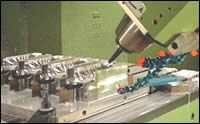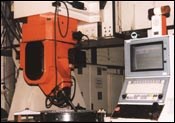Benefits of Positional Five-Axis Machining
Why rely on five-axis machining and where can it be applied; strategies and considerations for five-axis machining; and, cutter path optimization.
Some of the significant benefits to employing five-axis machining strategies in mold machining include reduced machining time, less hand finishing and improved surface finish. On the business side, there is improved mold quality, reduced lead-times, and much fewer setup errors—all of which lead to greater profitability.
Five-axis machining has been used in aerospace applications for many years, but it is only recently that the toolmaking industry has shown similar interest. The main advantage of five-axis machining is the ability to save time by machining complex shapes in a single setup. An additional benefit comes from allowing the use of shorter cutters that permit more accurate machining.
Positional Five-Axis Machining
Positional five-axis machining (also called 3+2) has long been available within some CAM software. With this technique, the machining fourth and fifth axis is oriented into rotational position and machining is carried out as a set of three-axis operations.
In addition to this, some CAM software offers continuous five-axis machining, which allows the user to create continuous five-axis toolpaths across complex surfaces, solids and triangulated models. The toolpaths are fully gouge-checked and support a wide range of machining strategies and all tool types.
Benefits
Benefits to positional five-axis machining include the effective use of shorter cutters and less tool overhang, faster cutting, longer tool life, improved machining accuracy and better surface finish simply by creating a series of orientation workplanes. Also, fewer setups are required with five-axis machining—resulting in time savings, fewer setting errors and much increased machine utilization.
Programming in five-axis is not as difficult as it may sound. Look for simple programming methods that are available through some CAM software. These packages allow high-speed machining techniques to be employed cost-effectively.
Experienced users can set up templates—saving time and errors on future programs—and full process simulation on the computer prevents mistakes on the shop floor. When moving to five-axis machining users may need to adjust fixturing and workholding strategies to permit access to the maximum number of part features possible in a five-axis setup. Standard workholding devices generally do not allow for clear access to multiple sides of the workpiece. Specialized five-axis fixtures, chucking mechanisms and magnetic workholding provide freer access to the component being machined.
Benefits to continuous five-axis machining include elimination of blend lines and the ability to continuously maintain proper cutting tool to surface orientation, resulting in better surface finishes and improved tool life. Fewer cutter passes, reduced cycle time and single setup all contribute to time savings, fewer setting errors and better access to undercuts.
Benefits to five-axis machining also generally include the efficiency of having just one machine for three-axis HSM, positional five-axis, continuous five-axis, five-axis drilling, and more. These machines also typically provide faster axes travel and spindle rpm. Plus, five-axis machines are becoming smaller and more rigid, further improving the results.
While these factors are developing, it is true that some may find that the cost of a five-axis process steep. This is often caused by a lack of understanding of the applications for five-axis in a particular market. Once a shop is able to fully understand where the benefits can be achieved, this argument often disappears. It also must be remembered that technology behind high-speed and five-axis machining continues to improve and open up more applications to these approaches. While these advances in technology can appear at first to be more expensive, the benefits in tool life, efficiency and operating cost more than offset these initial costs.
Strategies
Applications for five-axis machining include rib machining, corner picking, deep cavity or core machining, shallow draft surfaces and similar operations. Five-axis machining also allows more efficient orientation of ball end mills to work surface. Slot machining, undercuts, steep walls and five-axis drilling all are opportunities to use five-axis machining to your advantage.
A wide range of strategies for improving your process with five-axis techniques include through a curve, through a point, profiling, automatic calculation of tool position, gouge and collision checking on all toolpaths. Some CAM software also supports a full range of cutter designs.
Other roughing strategies include from a point, meaning that the tool is aligned so the axis passes through a specific point with the cutting end pointing away. Toward a line function aligns the tool so that the axis passes through a specified line with the cutting end pointing toward the line. Both allow access to areas unable to be reached with three-axis machining or to give better cutting conditions.
Drive surface five-axis means that the projection direction and tool orientation is determined by the drive surface. This feature acknowledges a single drive surface, but a multi-surface part, and assures full gouge protection. One common problem with five-axis toolpaths is that a tool may appear to wobble as it is kept normal to a surface being machined, which can result in poor surface finish. The ability to use a simplified reference surface solves this problem by eliminating this effect.
Swarf machining is a technique that allows side cutting with an endmill while proceeding along the surface of a part, such as the sidewalls of a tapered rib. A similar toolpath also may be generated from surfaces according to a set of wireframe references. All tool types including tapered tools may be used for swarf machining.
Wireframe swarf machining benefits include improved results over surface swarf machining in some cases. It is suitable where internal surface structure is poor, or where edge matching is not perfect.
Five-axis through-curve machining means that the tool position is controlled by a single curve, ensuring full control over toolpath movement. Benefits to this approach include elimination of potential machine tool collisions and improved surface finish due to greater control of machine tool kinematics.
Totally integrated toolpath verification provides a means of thorough gouge and collision checking. Verification and simulation of machine motion detects and displays potential collisions, axial movements and permits manual jogging in any axis to adjust motions. Again, select CAM software provides automatic collision avoidance, thus preventing costly crashes.
Cutter Path Optimization
CAM software also may provide the user a way to optimize cutter paths. Rainbow shading highlights machining sequences and colors are changed to indicate axis reversals. Predictive visualization takes into account cutter geometry, speeds and feeds. With new CAM features that analyzes cusps, a user can see a realistic representation of the cutter progress and effect, accurately showing the impact of feed and speed on the part surface and allows surface finish values to be predicted before actual machining.
Point redistribution offers a way to reduce machining time. In a recent ex-ample, a five-axis machining center with a 7500mm/min feedrate was able to achieve a 39 percent faster cycle time due to point redistribution compared to stan-dard toleranced data. Point redistribution allows the programmer to manipulate the smoothness of the toolpath as well as the distribution of points on that toolpath to achieve these results.
Conclusion
Five-axis machining programmed with the right CAM software offers users a practical strategy for reducing cycle times, fewer setups, improved surface finish and machining results, and extended tool life that are impossible with traditional three-axis machining.
Related Content
Speed, Productivity Gains and High Uptime Ease Decision for Second Five-Axis Machine
Byrne Tool + Design reduced setups and gained speed and productivity thanks to fast, accurate and compact five-axis CNC machining centers.
Read MoreThree Good Reasons to Switch from Three- to Five-Axis Machining in Moldmaking
Five-axis machining technology is a great tool in the moldmaker toolbox.
Read MoreHow to Eliminate Chatter
Here are techniques commonly used to combat chatter and guidelines to establish a foundation for optimizing the moldmaking process.
Read MoreDesign Strategy Tackles Big and Small Complexity Challenges for Southeastern Mold Builder
Delta Mold Inc.’s core values, engineering expertise, five-axis machines and molding capabilities help the team turn a proposal into a manufactured mold or part with custom design, finishing and assembly.
Read MoreRead Next
Crash Test Genius
Toolpath verification software has evolved to permit simulation of the entire machining system.
Read MoreMoving Mold Design From 2-D to 3-D
Moving to 3-D mold design can provide a very effective way of improving competitiveness and helping companies win more business.
Read MoreA Specialized Mold Design Strategy
Solving complex mold design challenges with specialized CAD software.
Read More

























.jpg;maxWidth=970;quality=90)